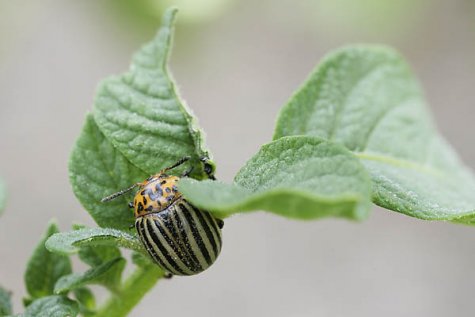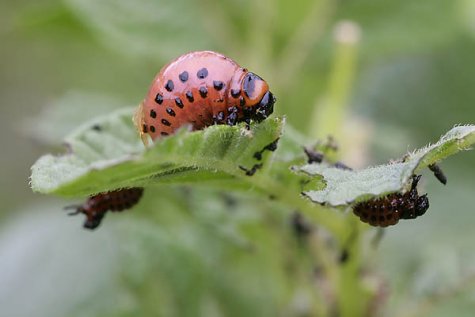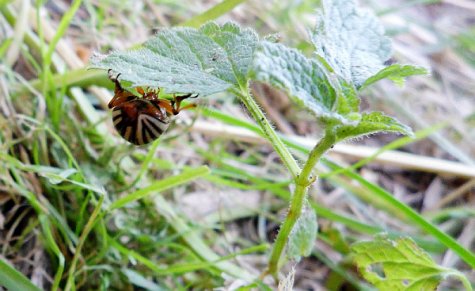We have to talk about the Colorado beetle every year
Text: Urmas Tartes
Photos: Arne Ader
Translation:Liis
Colorado beetle; Colorado potato beetle Kartulimardikas or after origins, koloraado mardikas Leptinotarsa decemlineata
The beetle is up to 10 mm long, bright yellow / orange, with covering brown stripes. The most efficient preventive is to pick the beetles and their larva manually, and to crush the orange eggs on the plant leaves; for spraying an environmentally-friendly sweet basil extract can be used.
On October 12 1492 Columbus surprised the inhabitants on the Bahama islands with the information that from now on they were subjects of the Spanish king. Of course such insolence from the invaders was not allowed to go unpunished by the native inhabitants.
It took a little less than four centuries until the invaders sent out from America reached the European shores for the first time. After the Second World War the invaders had captured all Europe. And the conquest took place without any gunshots whatsoever, aided by the Europeans themselves.
Smart strategy
First of all about half a century after the conquests of Columbus an action started to make Europeans dependant of the potato plant used by the Incas of Peru and Bolivia. The start was slow. The first reports of potatoes cultivated for food came from the end of the 16th century, from Spain.
For the spread of the potato across all Europe some hundred more years were still needed, because the plant with the poisonous above-ground parts was treated with prejudices. But then the harvest was so good that the potato became the most important food plant of the whole population. The potato for instance produced much more stable yields than for instance wheat and was not damaged by wet summers. For instance in Ireland the proportion of potatoes in food in the beginning of the 19th century was up to 80%.
With the aid of potato cultivation the European population grew and the industrial revolution took place. To North America the potato was brought by European immigrants. So the groundwork for the spread of the striped-coated conqueror was laid.
The striped conqueror
In 1824 the entomologist Thomas Say described a new yellow, black-striped beetle species that had been collected in the American Rocky mountains from a wild species of the nightshade or Solanaceae family. When the beetle was found in great numbers in 1867 on a wild nightshade in the state of Colorado the name Colorado beetle began to be used. In fact it is likely that the original home of the Colorado beetle is Mexico, but no entomologists were doing investigations in Mexico at the time.
In any case no one suspected a connection between the beetle and the potato cultivated for food because all previous finds had been from wild plants. But when the European immigrants who colonised America had cultivated the potato widely the road of the Colorado beetle to the ports of the east coast and from there by steamships to Europe was open.
At first the Colorado beetle was discovered in a potato field in 1859 in the state of Nebraska. The insect had reached the American east coast by 1874. The first permanent population was found in France in 1922.
After the Second World War the Colorado beetle spread rapidly throughout Europe and today has already reached Asia.
In Estonia the Colorado beetle was found for the first time in 1965. Then it was hoped that the few occasional migrant individuals would perish in the winter cold. In the beginning this was true but by now the potato beetle is already a permanent inhabitant in Estonia. Obviously the milder winters and hot summers have helped.
Thorough devourer
The Colorado beetle larva spend the winter in the soil under the snow. In spring the beetles lay their orange collections of eggs on the potato leaves.
One beetle can lay up to 800 eggs. Both the beetle larvae and the beetles eat stems and leaves of the potato plant. If the beetles are numerous they can destroy the whole potato crop. In addition to potatoes they sometimes also eat tomato plants.
Today the beetles have become resistant to all the common insecticides. The revenge of American nature on the European conquerors has been severe and efficient. The yields of the most important food plant are at risk each year.
In their homeland Mexico the Colorado beetle does not eat potatoes but feeds as before on its original food plants, the wild nightshades.
In Jõgeva there are Colorado beetles in the gardens, Vello Keppart reports.
Young nature lovers Hanna and Eliise found Colorado beetles in their garden in Räpina yesterday. Father helped them to take a photo.
Photo by Kaido Einama











